British Needle Telegraph and Railroad Signalling
The first electromagnetic telegraph system was not the one invented by Samuel F.B. Morse, but rather the British Needle Telegraph system, invented by W.F. Cooke and Charles Wheatstone in 1837. (Students of Physics and Engineering will also recognize Wheatstone's name as he was the inventor of the Wheatstone Bridge). The needle telegraph was used by the British Railway to send messages between stations along the train route. Needle telegraphs were used by the railroads throughout the rest of the 19th Century and into the 1930's.
The first needle telegraph invented by Cooke & Wheatstone used 5 needles on a diamond-shaped board. It was simple to use, as it did not require the operator to learn any kind of code. They just looked at the letter to which the needles were pointing and that was it. The 5-needle system only lasted a year or so because of the difficulty in maintaining a system with 5 wires. Eventually, deterioration of the insulation covering the wires resulted in the system being abandoned.
The 5-needle system was replaced with a 2-needle system that was easier to maintain. The double needle system did require the operator to learn the "code" associated with the needle movements required for each letter. The double needle system was used through the 1840's and was eventually replaced with a single needle system. A chart showing the codes for the different needle systems can be found here.
There was also a 4-needle system that was used for a short time. I have not seen any examples of the 4-needle instrument, but a drawing of one can be seen here.
Below you will find descriptions and photos of each of the needle telegraph systems, as well as photos of some Railway Signal Block Indicators, which were single needle telegraph units specifically used to prevent two trains from trying to use the same length of track.
More information on the needle telegraph can be found on Wikipedia.
Sam Hallas also has an excellent website with information about how the single needle telegraph works.
(Click on the pictures below to see larger versions of the photo)
Cooke & Wheatstone 5-Needle Telegraph
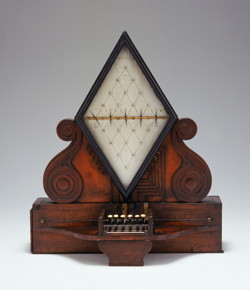 |
One of the few surviving examples of a Cooke & Wheatstone 5-needle telegraph. Circa 1839. |
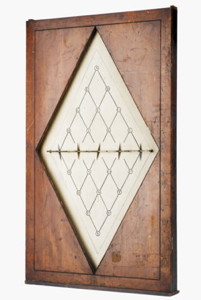 |
This is one of the 2 original prototype units of the 5-needle telegraph made by Cooke & Wheatstone in 1837. |
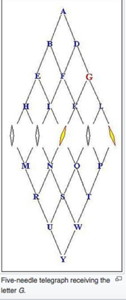 |
An example of the 5-needle telegraph receiving the letter "G". Note how the 2 needles point to the desired letter. Needle movements were controlled by 2 rows of buttons at the front of the instrument. With the 5-needle system, only 20 possible letters could be produced; hence, some letters of the alphabet had to be omitted. The omitted letters were C, J, Q, U, X, and Z. These letters were replaced with different letters or a combination of letters. For example, "C" was replaced with "S", "Q" was replaced with "KW", etc. Hence, a bit of creativity was required by the operators. (Image from Wikipedia.com) A short video of a working replica of the 5-needle telegraph can be seen in this YouTube Video. |
Cooke & Wheatstone Double Needle Telegraph
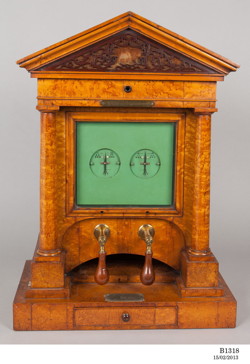 |
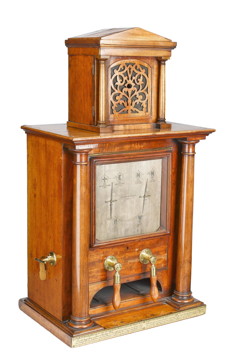 |
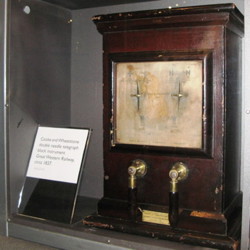 |
|---|
Some examples of the Cooke & Wheatstone Double Needle Telegraph.
Unlike the 5-needle telegraph, the double-needle instrument used 2 large pump handles that hung down at the front to control needle movements. The handles were rotated slightly to the right or left to deflect the needles in those directions.
 |
 |
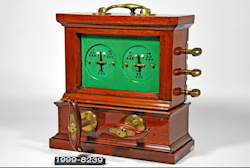 |
Another nice example of a double needle telegraph set.
 |
 |
 |
 |
A late model double needle telegraph set. Note that one of the dials is marked "General Post Office". Prior to 1868, British telegraph companies were under private ownership. In 1868, the government formed the GPO (General Post Office), so this set was made after 1868
Cooke & Wheatstone Single Needle Telegraph
 |
 |
 |
 |
A very early Single Needle Telegraph made by Electric Telegraph Company, London. 1846
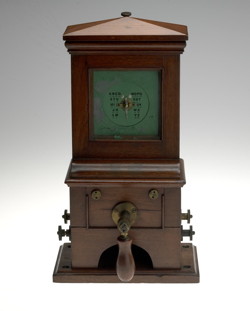 |
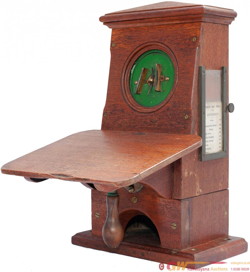 |
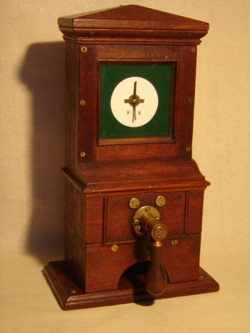 |
Above are more examples of Single Needle Telegraph sets. The earlier sets had the codes for each letter printed on the front face. Similar to the double-needle telegraph, the single needle instrument also used a large pump handle (or a winged knob) to control needle deflections to the right or left. The early single-needle instruments used a unique code like shown on the face of the Izant instrument shown below, but eventually they started to use a code that was essentially the same as the International Morse Code (see the example above top left).
A short demonstration of the Single Needle Telegraph can be seen in this YouTube Video. (PK Porthcurno Museum of Global Communication)
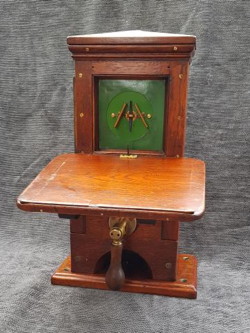 |
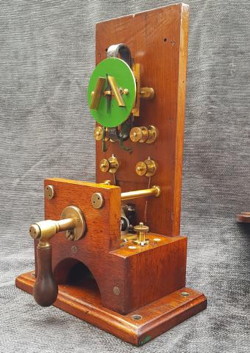 |
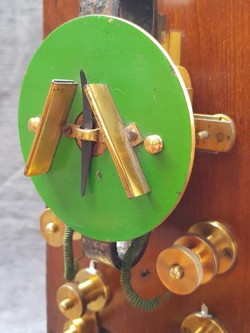 |
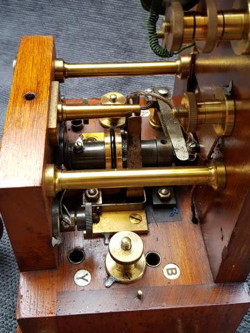 |
Some close-ups of the internal mechanism of a Single Needle Telegraph.
 |
Dering's 1852 Patent Single Needle Telegraph |
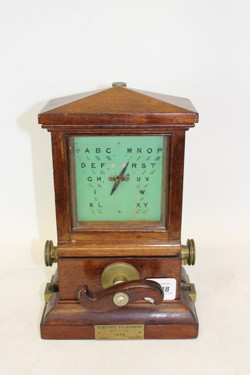 |
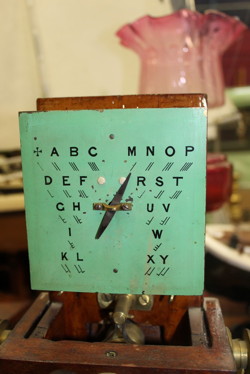 |
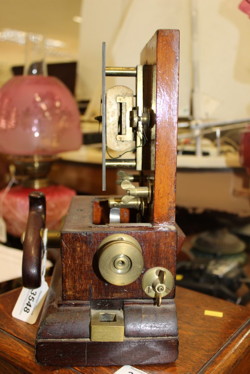 |
A nice Single Needle Telegraph set by Henry Izant & Co, London. Ca. 1854. Izant was in business from 1850-1868.
Signal Block Indicators
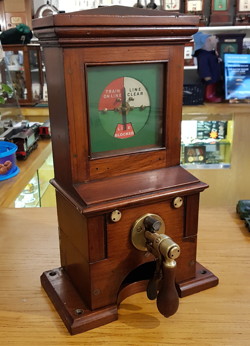 |
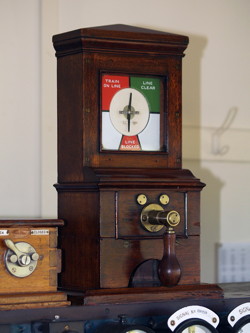 |
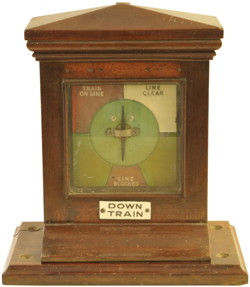 |
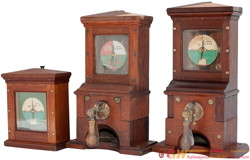 |
Above are some examples of Railway Signal Block Indicators, which were used to ensure that only a single train could occupy a "block" (section of track) at a given time. Many of the earlier signal block instruments used a large pump handle like the single needle telegraph sets.
More information of Signal Block Indicators can be found on Wikipedia, and also at railsigns.uk
People interested in purchasing a Railway Signal Block Indicator can visit the website junctionrailwayana.com
Block Bell & Key Instruments
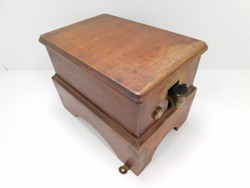 |
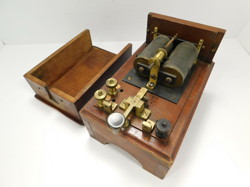 |
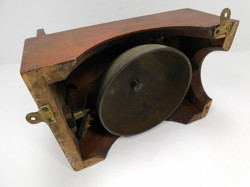 |
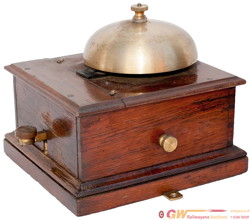 |
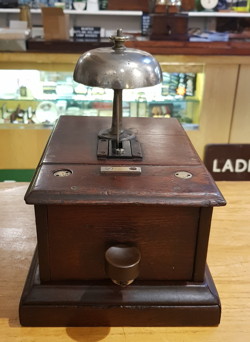 |
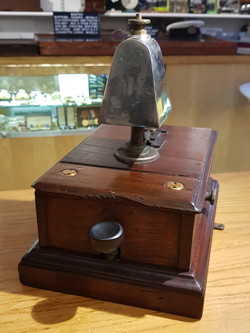 |
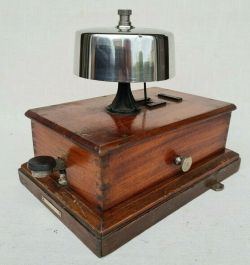 |
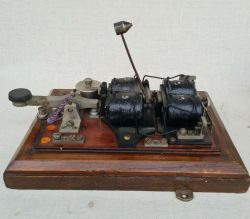 |
In addition to signal block indicators, the British railways also used Block Bell Instruments to communicate between neighboring signal towers.
These instruments consisted of a relay, key, and a large signalling bell. The signalmen used standardized bell codes to communicate information about the status of the line; i.e. whether the line was clear or if a train was occupying a certain block (section of track). These instruments were typically built into nicely made, polished wood boxes. Some block bell instruments had the bell mounted on top of the box, while others had the bell mounted underneath.
The website junctionrailwayana.com has Block Bell Instruments for sale for those interested in purchasing one.
